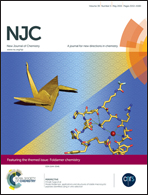Effects of temperature on the preparation and characteristics of hydroxyapatite and its adsorptive properties toward lead
Abstract
Hydroxyapatite (HAp), [Ca10(PO4)6(OH)2], was successfully synthesized by a combustion method in the aqueous system containing calcium nitrate, di-ammonium phosphate and urea. The effect of calcination temperature on the composition of the HAp phase was studied using XRD, FTIR, ATD/ATG, and N2 adsorption. It was found that at 500 °C and 700 °C, the dominant phase in the powders was HAp with small amounts of β-tricalcium phosphate (β-TCP), and only the HAp phase was observed at 300 °C. The synthesized HAp2 with a higher specific surface area (48 m2 g−1) was used for the removal of Pb2+. The following parameters contact time, initial concentration of lead and temperature were studied in batch experiments. Kinetic studies showed that the pseudo-second-order kinetic model was an appropriate model to describe the dynamic behavior of the adsorption process. The Langmuir isotherm model was certainly fitted to the equilibrium data. HAp2 can then be used as an effective adsorbent for removal of Pb2+ from aqueous solution.


 Please wait while we load your content...
Please wait while we load your content...